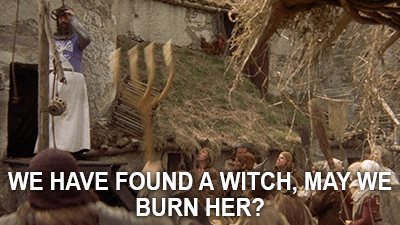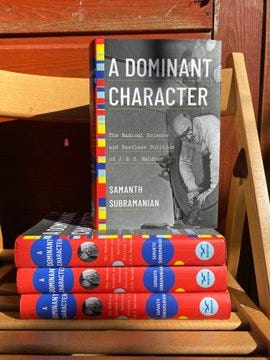multi-storied #2: Arson. Buffet.

I wrote a column for Politico Europe about arsonists trying to burn down 5G towers across Europe, and compared it to the practice of burning witches—which occurred not in the so-called “Dark Ages” but during the Renaissance and its flowering of rational thinking:
The 16th century, too, was a time of immense flux. The climate had been shifting; a Little Ice Age was digging in, and Europe was hit by droughts and poor harvests. The plague was always around; a fierce flare of disease set in around Roermond in 1613, just when its authorities were conducting their witch trials. The old, stable orders of society were breaking down. The Catholic Church was being challenged; feudalism was crumbling. The upheavals unsettled everyone. “Immense sadness and a feeling of doom pervaded the land,” the scholar Robert D. Anderson wrote. Historical concordances are always inexact, but the tenor of that time sounds acutely familiar to us. In both these periods of turbulence, people looked for someone to blame.
While reading about witch-burning, I learned about a book called Malleus Maleficarum, or Hammer of Witches, the defining tract on how to identify witches and punish them. (“Witchcraft comes from carnal lust, which is in women insatiable…”) Malleus, written by a Catholic clergyman, was a runaway hit. Twenty editions of it were published in 33 years. The wide spread of its lies—propaganda, really—was helped immeasurably by the invention of the printing press, just a few decades prior. The printed book, the vehicle of enlightenment, was, even in its earliest years, also a carrier of superstition and falsehood.
It made me think about the early years of the Internet, which I’m old enough to remember—about the utopianism surrounding this new technology and its potential to democratize information, to render the world utterly transparent. We see now, of course, that it didn’t exactly turn out that way. To paraphrase one scholar of witchcraft: the swift propagation of fake news online has been evidence that the Internet has not liberated man from original sin. But I wonder how, knowing what they did about the prompt misuse of previous technologies like the printing press, the pioneers of the Internet kept their utopian dream intact. There must be a good book to read (or to be written!) about those first, rose-tinted years, when the world started to come online.

The first American review of “A Dominant Character” just came out, in The American Scholar. The TL;DR version is that the reviewer David Brown finds the title flat but the book itself “full of insight and felicitous writing.” I’ll take that! The magazine devotes a full two pages to the book, which is terrifically gratifying.
For American readers of this newsletter, the US edition of the book is now available for pre-order on Amazon. What excellent timing, you say: just as we’re learning about the messy clashes of science and politics in Covid vaccine development, in lockdowns and reopenings, in the privacy issues of contact tracing, in basic questions of who lives and who dies during the pandemic. I couldn’t agree more.
For subscribers of this newsletter who follow this kind of thing, tell me: What should I be reading if I want to know more about the way Warren Buffet buys companies? Or the way his companies buy companies? What’s the philosophy behind it? Who should I be talking to, if I want to know more? Email me!

It may be a little early in the day for meta-musings about publishing and newsletters, but a friend sent me a couple of articles that argue that newsletters are A Bold Way of the Future for creative types looking to make a living. (One was an Andreessen Horowitz blog post. Yeah, a VC firm is casually suggesting that you find 100 people to pay you $1,000 a year for your output. Make of that what you will.) With the caveat that I approach this from a journalist-writer’s point of view, I thought these arguments were terribly unsound. (Substack, don’t ban me!) Because:
I don’t think this is scalable across the industry. There are too many writers / artists / whatever for each of them (or even a good portion of them) to be able to earn this kind of income. This is particularly true in India. What will happen is that the people who already have some brand equity of their own will probably be the ones who make a six figure income (USD per year)—and arguably they’re the ones who need it least. To set this up as a solution for a lot of people is false. It’ll help some people, maybe. It isn’t some lifesaver for any significant percentage of professionals.
This suggestion of the one-person newsletter ignores the fact that a lot of the final product in journalism / writing is the result of institutional quality control: editors, fact checkers, illustrators. So this newsletter / personal brand initiative’s final product isn’t fungible with what a journalist would have produced if she was part of an institution. The institutional product will be of higher quality, almost always. And we want that, with something like journalism: we want it to be as good as it possibly can.
A chief purpose of journalism is to expose readers to material they wouldn’t have otherwise encountered. A subscriber base is inherently self-selected. Emily Atkins, who is quoted in the Times piece, runs a climate newsletter called Heated. I’m willing to bet that the people receiving her newsletter are just as angry as her about the lack of action on climate change. If she was at a newspaper, she’d have the opportunity to reach someone who hadn’t previously thought about climate change or paid it attention. I’d argue this will set up more echo chambers, which isn’t really a good development, given how polarized so much of the media and public sphere already is.
The chief problem I have is a more fundamental one. Which is: It feels to me like journalism, which was once a proper, structured, thriving industry, is now being told that its professionals can subsist on goodwill and “donations.” That is an unviable long term strategy, because donations and goodwill can switch targets. No real corporation—by which I mean tech, banking, all the so-called “left-brain” sectors that Andreessen Horowitz would invest in—would ever seriously look at goodwill and donations as a business model. And yet the creative industries are being sold this solution, as a substitute for having their sectors gutted. In fact, you could even (very) broadly say that the same tech sector that has hollowed out media (unconsciously, for the most part, but also consciously, as in the case of Facebook lying about video engagement figures) is now selling its platforms as a solution to professionals who’ve had their livelihoods cut down.
If I have to build a pyramid of “donors,” I’m accepting that my “product” has no inherent value of its own. In fact, a donation is proof that a product is not monetizable. Because however you look at it, it isn’t a purchase. So it comes awfully close to begging, the thought of which I hate.
The irony of multi-million dollar companies encouraging writers and artists to go it solo, to leave behind the security and support of an institution and to self-publish, self-sell, self-whatever—well, it’s just so 2020. Having said that: look, if any of you do want to pay me $1,000 a year…



